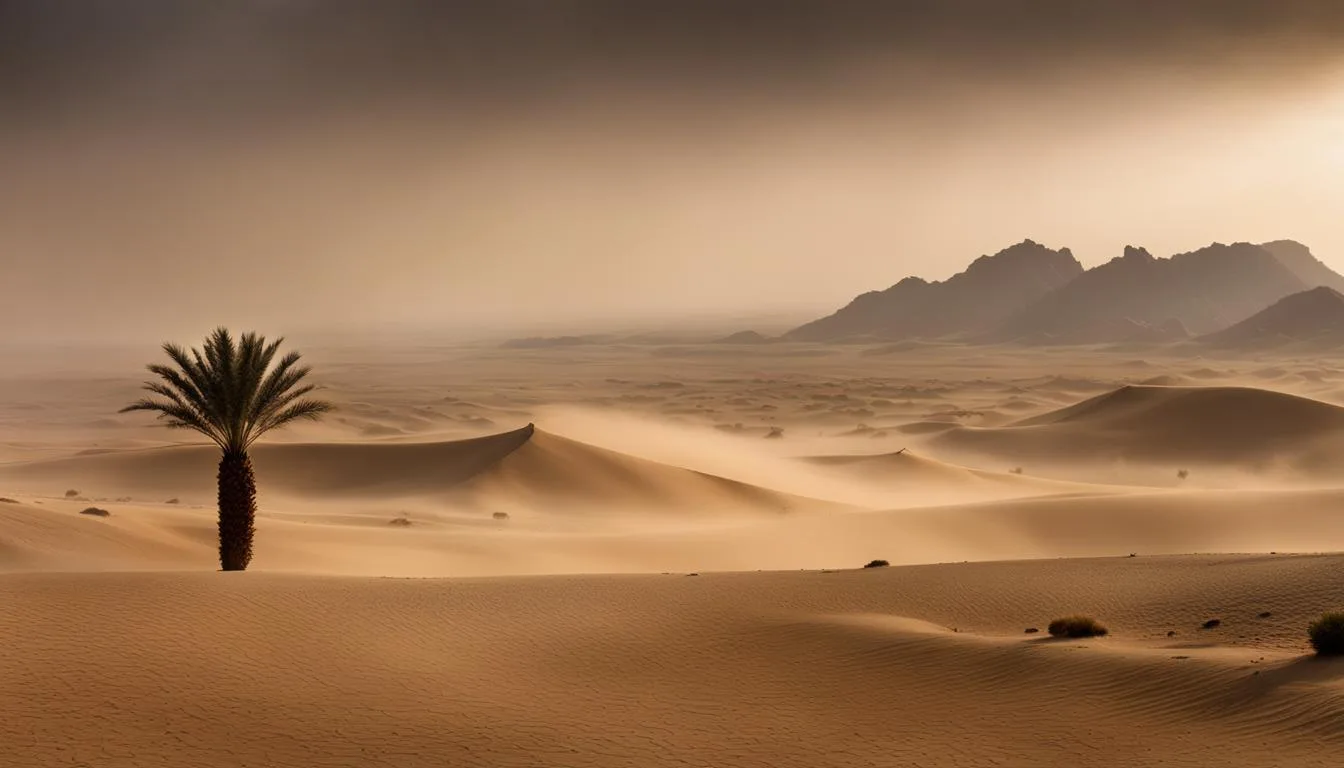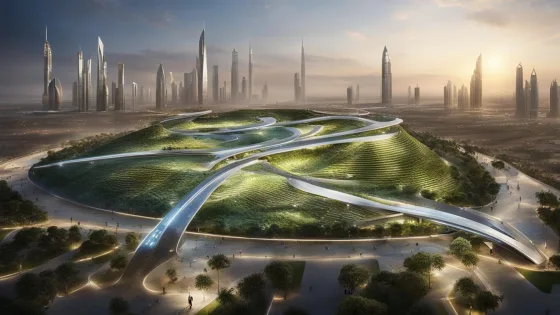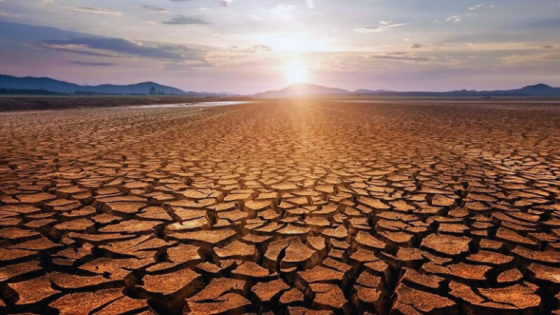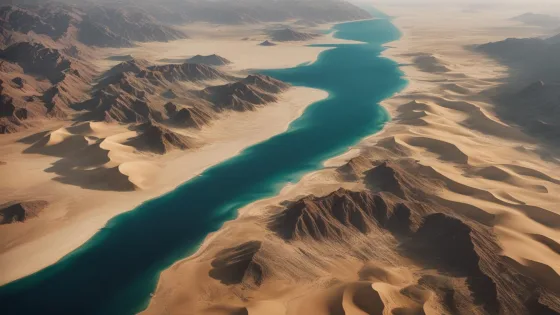Contents
The climate of the United Arab Emirates (UAE) presents a unique tapestry of challenges and opportunities within the sphere of sustainable development. A thorough understanding of the Seasonal Weather Patterns in UAE is not just a matter of meteorological interest but a key factor shaping the nation’s environmental strategies. As the UAE asserts its global leadership by hosting key climate conferences like COP28, the relation between its distinct arid conditions and Climate Change Effects in UAE comes under global scrutiny.
Your grasp of the UAE Climate Overview will illuminate the intricate balance between economic progress and Environmental Policies in UAE. This interplay is crucial as the UAE marches toward exemplary Sustainable Development in UAE, leading by example to mitigate the impact of climate change and foster a resilient future for its denizens and the world at large.
Understanding the UAE’s Arid Desert Climate

As you explore the unique environmental facets of the United Arab Emirates, it becomes evident how the nation’s arid desert climate shapes every aspect of life, from the UAE Desert Ecosystem to the innovative approaches in Water Resource Management in UAE. The stark beauty of its landscape and the remarkable adaptations of its inhabitants and policies highlight the critical influence of climate conditions in the region.
Seasonal Weather Patterns and Temperature Shifts
In the UAE, the heat of the sun is a constant companion, manifesting in extreme temperature fluctuations throughout the year. During the summer, which spans from June to September, temperatures in the arid deserts can soar over 50°C in the shade. This intense heat takes a toll on the delicate equilibrium of the UAE Desert Ecosystem and influences the daily lives of its people.
Conversely, winters introduce a milder climate, with temperatures ranging comfortably from 16.4°C to 24°C. This period is essential for outdoor activities and wildlife, offering a brief respite from the relentless heat, although it remains imperative to monitor Climate Change Effects in UAE even during these cooler months.
Transitional Periods: From Hot Summers to Mild Winters
The UAE’s climate is punctuated by two transitional periods, with April to May representing a time of escalating temperatures, setting the stage for the scorching summer ahead. Then, as the intensity of the heat begins to wane in October and November, the country finds reprieve with more moderate conditions that introduce the winter season. These transitions are not just a matter of comfort but impact deep-rooted environmental concerns, particularly in the realm of climate adaptation and Water Resource Management in UAE.
UAE’s Unique Weather Phenomena: Dust Storms and Shamals
Within this climatic narrative, the UAE is also subject to its own unique weather phenomena. Dust storms and shamal winds, sometimes sweeping through with sudden force, can dramatically affect visibility, air quality, and operations across the country. These natural occurrences are stark reminders of the Climate Change Effects in UAE, asserting an unpredictable element into the lives of its citizens and environmental policymakers alike.
Understanding these weather patterns is critical as the UAE navigates the challenges of climate change and strives for sustainability in an arid, yet vibrant, desert ecosystem.
UAE Climate Overview
The stark and spectacular landscape of the UAE is a testament to the power of nature’s extremes. In this section, we delve into the ways in which the region’s arid climate poses challenges and carves opportunities for Sustainable Urban Planning and Water Resource Management. The UAE’s meteorological profile is a pivotal factor for Urban Planning and Climate mitigation strategies in the UAE. Let’s examine closely how these environmental characteristics affect the delicate UAE Desert Ecosystem and everyday life in the region.
Fluctuations in Annual Rainfall
In the UAE, the word ‘rain’ often brings a sense of novelty rather than normalcy. Annual rainfall ranges from a scant 140 mm to about 200 mm, impacting not just the natural landscape but Water Resource Management strategies in the UAE. In the more forgiving mountainous areas, precipitation can peak at around 350 mm, highlighting the spatial variance within the country. The irregular distribution of precipitation demands intelligent solutions to sustain a growing population and a burgeoning economy.
Temperature Extremes and Regional Variations
The varying temperatures in the UAE serve as a reminder of the region’s environmental extremities. Over the scorching summer months, temperatures can skyrocket, which has profound implications for Urban Planning and Climate in the UAE. Cities must be designed with materials and spatial considerations that mitigate these conditions. Winter months offer a temperate period, which introduces different planning and lifestyle adaptations for both residents and the unique desert fauna and flora.
Implications of An Arid Climate on Daily Life
Daily life in a region where the climate is arid and the temperatures can be extreme requires thoughtful adaptation. Wardrobe choices, architectural design, and even the rhythm of daily activities are all dictated by an understanding and respect for the desert climate. Energy efficiency and conservation take centre stage, ensuring that Water Resource Management and Urban Planning in the UAE prioritize sustainability to preserve the delicate UAE Desert Ecosystem.
This deep interconnection between the climate and the inhabitants of the UAE is not merely about survival; it’s about striving for a harmonious coexistence with one of the planet’s most challenging environments.
Impact of Climate on UAE Tourism
As you consider visiting the United Arab Emirates, it’s important to recognize how the Impact of Climate on UAE Tourism shapes the experience throughout the year. The UAE Climate Overview reveals a landscape starkly divided by extreme seasonal shifts—a factor indispensable for travel planning. With its Seasonal Weather Patterns in UAE, choosing the optimal time for your visit is as strategic as it is practical.
Best Times to Visit: Weather Considerations for Tourists
Your journey to the UAE can vary dramatically depending on the time of year. Winters are mild and welcoming, typically regarded as the peak tourist season. With average temperatures between 16.4°C to 24°C, winter emerges as the prime time for you to delve into outdoor markets, desert excursions, and the rich culture of the UAE without the summer’s scorching heat.
Attractions and Activities Suited to the UAE’s Climate
No matter when you visit, you’ll find attractions and activities designed to complement the nation’s weather. From the refreshing aquamarine waters inviting you to its beaches to the climate-controlled modern marvels, like the mega malls of Dubai, the UAE caters to visitors with a range of preferences. Venture out for a night-time desert safari to cherish the cooler desert clime under starlit skies, or escape the midday sun in underwater aquariums, all thoughtfully adapted for your comfort and safety regardless of exterior conditions.
How Tourism Adapts to Seasonal Weather Changes
Your visit to the UAE during summer necessitates an adaptation to extreme temperatures. Scheduling outdoor activities during cooler mornings or after sunset can ensure your health and enjoyment while basking in the UAE’s rich cultural tapestry. Tourism providers adeptly adjust by offering more indoor activities or nocturnal events that allow you to discover the UAE without the heat-induced constraints. This adaptability underscores the unique relationship between UAE’s tourism industry and its pronounced climate narrative.
The intertwining of tourism with climatic conditions not only enriches the visitor experience but also influences the local economy. Understanding the far-reaching Impact of Climate on UAE Tourism, with its ebb and flow driven by the Seasonal Weather Patterns in UAE, ensures your time in this grand country is both engaging and memorable.
UAE’s Steps Towards Sustainable Development
The United Arab Emirates is pioneering Sustainable Development in UAE with a clear vision to harmonize its rapid urban growth with its environmental commitments. Your understanding of the UAE’s actions in the framework of Environmental Policies in UAE and Renewable Energy Initiatives in UAE will highlight the remarkable journey this nation is undertaking.
Recognizing the unique environmental challenges posed by its arid desert climate, the UAE has enacted numerous programs and policies that underscore its dedication to ecological stewardship. These measures represent the UAE’s commitment to reducing its carbon footprint and safeguarding natural resources for future generations. Let’s delve into some of these strategic initiatives.
-
Advancing Rewable Energy Initiatives in UAE has been a cornerstone of the country’s sustainability strategy. Projects like the Mohammed bin Rashid Al Maktoum Solar Park and the Shams 1 solar power station showcase the UAE’s significant investments in harnessing solar energy.
-
The UAE has not only embraced solar but has also diversified its renewable sources of energy. The Barakah nuclear energy plant is a testament to this broadened approach, being the first commercial nuclear power station in the region.
-
Urban development goes hand in hand with sustainability, and the UAE’s implementation of green building codes aim to reduce the ecological impact of new developments, a facet of the Environmental Policies in UAE.
-
At the community level, Masdar City represents the UAE’s commitment to Sustainable Development in UAE by functioning as a hub for clean-tech companies and sustainable urban living.
-
Exemplifying its role in international environmental discourse, the UAE is scheduled to host COP28, a pivotal moment for global climate action and collaboration.
These efforts collectively mark a transformative epoch in the UAE’s endeavors, as they redefine what it means to balance ecological integrity with progressive development.
| Initiative | Focus Area | Impact |
|---|---|---|
| Mohammed bin Rashid Al Maktoum Solar Park | Solar Energy | Provision of clean energy and reduction in carbon emissions |
| Barakah Nuclear Energy Plant | Nuclear Energy | Diversification of energy sources and sustainable capacity-building |
| Green Building Codes | Urban Development | Guidance for eco-friendly construction and efficient resource utilization |
| Masdar City | Sustainable Urban Planning | Facilitation of green businesses and promotion of sustainable living practices |
| COP28 Hosting | Global Climate Action | Strengthening UAE’s leadership in international climate negotiations |
The measures undertaken by the UAE underscore a seasoned understanding of the fact that sustainability and modernity can indeed flourish hand in hand. As you observe the strategic measures being implemented in the Renewable Energy Initiatives in UAE, you can witness a powerful narrative of a nation firmly rooted in the present yet dynamically advancing towards a sustainable and resilient future, thus shaping the global narrative for Sustainable Development in UAE.
Renewable Energy Initiatives and Environmental Policies in UAE
As you explore the United Arab Emirates’ commitment to sustainability, you’ll find that substantial strides have been taken in the realms of Renewable Energy Initiatives and Environmental Policies. The UAE’s ambitious vision incorporates a comprehensive suite of strategies, from clean energy projects to legislative frameworks, all converging towards a more sustainable and environmentally conscious nation.
Investing in Clean Energy: Solar and Nuclear Ventures
The UAE recognizes the indispensable role of renewable energy in ensuring a sustainable future. Notably, the nation has made significant investments in solar energy, evident through launching colossal projects like the Mohammed bin Rashid Al Maktoum Solar Park. This initiative isn’t just about generating renewable energy; it’s a statement of intent, setting a precedent for Sustainable Urban Planning and Architecture that integrates seamlessly with the UAE Climate Overview.
Nuclear energy also plays a crucial role, as seen through the Barakah nuclear energy plant. As the first commercial nuclear power station in the Arab region, Barakah stands as a pinnacle of diversification in the UAE’s energy sector, underscoring a bold step towards clean energy advancement.
Legislative Framework for Environmental Protection
Aligning with global environmental standards and commitments, the UAE has crafted a robust Legislative Framework for Environmental Protection. Regulations and policies are integral to safeguarding natural heritage, ensuring responsible stewardship over the environment, and cultivating a culture of sustainability. These legislative measures bolster the nation’s aim to transition towards a green economy, guided by the principles of conservation and sustainable development.
Pioneering Sustainable Urban Planning and Architecture
Innovation in the UAE’s urban design reflects an acute awareness of the region’s inherent climatic challenges. Pioneering Sustainable Urban Planning and Architecture is evident in flagship projects such as Masdar City—a model for sustainable community living. Emphasizing environmentally friendly design, buildings in the UAE utilize strategies like passive cooling, solar shading, and green spaces to mitigate extreme temperatures, all in line with superior environmental standards.
An overarching theme of the UAE’s sustainability efforts is the harmonious balance between development and ecological preservation. As a global leader in renewable energy and eco-conscious development, the UAE not only aims to revolutionize its infrastructure but also aspires to set a benchmark for sustainable living in arid landscapes around the world.
| Energy Project | Type | Capacity | Goal |
|---|---|---|---|
| Mohammed bin Rashid Al Maktoum Solar Park | Solar Power | 5,000 MW by 2030 | Reduction of carbon emissions |
| Barakah Nuclear Energy Plant | Nuclear Energy | 5,600 MW | Energy diversification |
| Masdar City Initiatives | Sustainable Urban Development | N/A | Green building certification and carbon neutrality |
Your awareness of these Renewable Energy Initiatives in UAE allows you to appreciate the nation’s sophisticated approach to reconciling economic vitality with environmental prudence, an integral aspect of the UAE’s promise for a sustainable future.
Conclusion
As we examine the UAE’s approach to confronting its unique environmental challenges, it becomes clear that the nation is embarking on a path that melds domestic environmental stewardship with far-reaching global ambitions. With the UAE Climate Overview presenting a vivid tableau of the intense climatic conditions and the innovative responses this has engendered, your appreciation of the nation’s bold steps towards Sustainable Development in UAE is well-founded.
UAE’s Climate Challenges and Global Leadership Role
The dichotomy of the arid climate and the burgeoning modernity of the UAE paints a complex picture of Climate Change Effects in UAE—one that the country has not shied away from addressing head-on. The UAE’s Environmental Policies reflect a commitment to not just navigating these challenges, but also sharing their insights and pioneering initiatives on an international stage. As an active participant in global discussions and treaties such as the Kyoto Protocol and the Paris Agreement, the UAE has consistently shown that international collaboration and local action must symbiotically drive the climatic adaptive process.
Preparations for Upcoming Climate Conferences and COP28 Impact
Your understanding of the Preparations for Upcoming Climate Conferences, notably the anticipation surrounding the United Arab Emirates’ hosting of COP28, adds depth to our overview. Recognizing the enormity of this event, the UAE’s meticulous planning and inclusive agenda setting underscore its role as a convener of critical dialogue and incubator of actionable solutions. COP28 is more than a summit; it’s a beacon that casts a global spotlight on the imperative of pressing forward with tenacity and vision to mitigate climate change. This event is poised to be a significant milestone, potentially catalyzing a watershed moment in the global climate narrative.
Future Directions for UAE’s Climate Resilience
Looking forward, the UAE’s trajectory of resilience in an era of climate uncertainty sets a precedent for others to emulate. As the UAE continues to adapt, innovate, and enact Environmental Policies in UAE that spur on Sustainable Development, its strategic positioning as a nation unites economic ambition with ecological mindfulness. The future directions will undoubtedly build upon the strong foundation highlighted in this UAE Climate Overview—anchoring a legacy that prioritizes a balanced ecological equation for generations to come. As spectators and participants in this unfolding story, your awareness and engagement with the UAE’s climate reality deepen the global commitment to a more sustainable and inclusive future for all.













